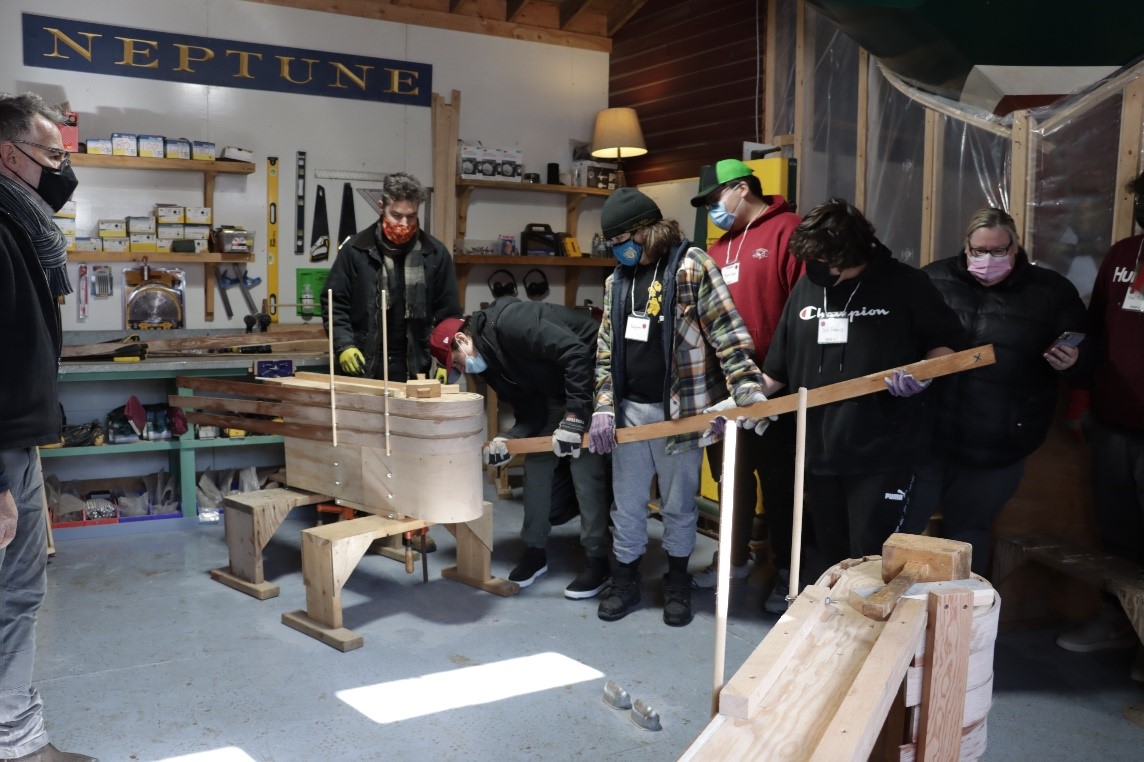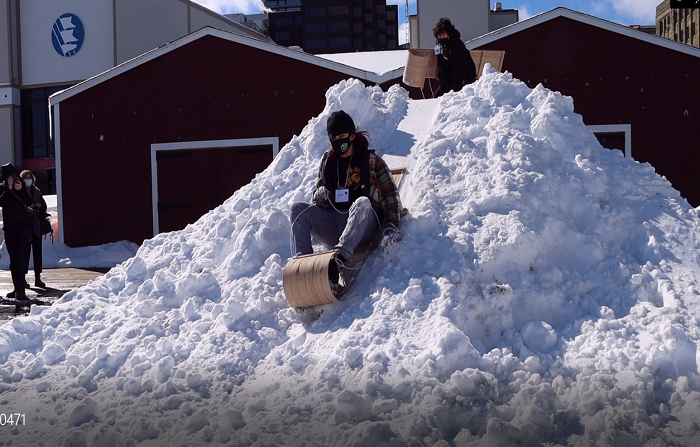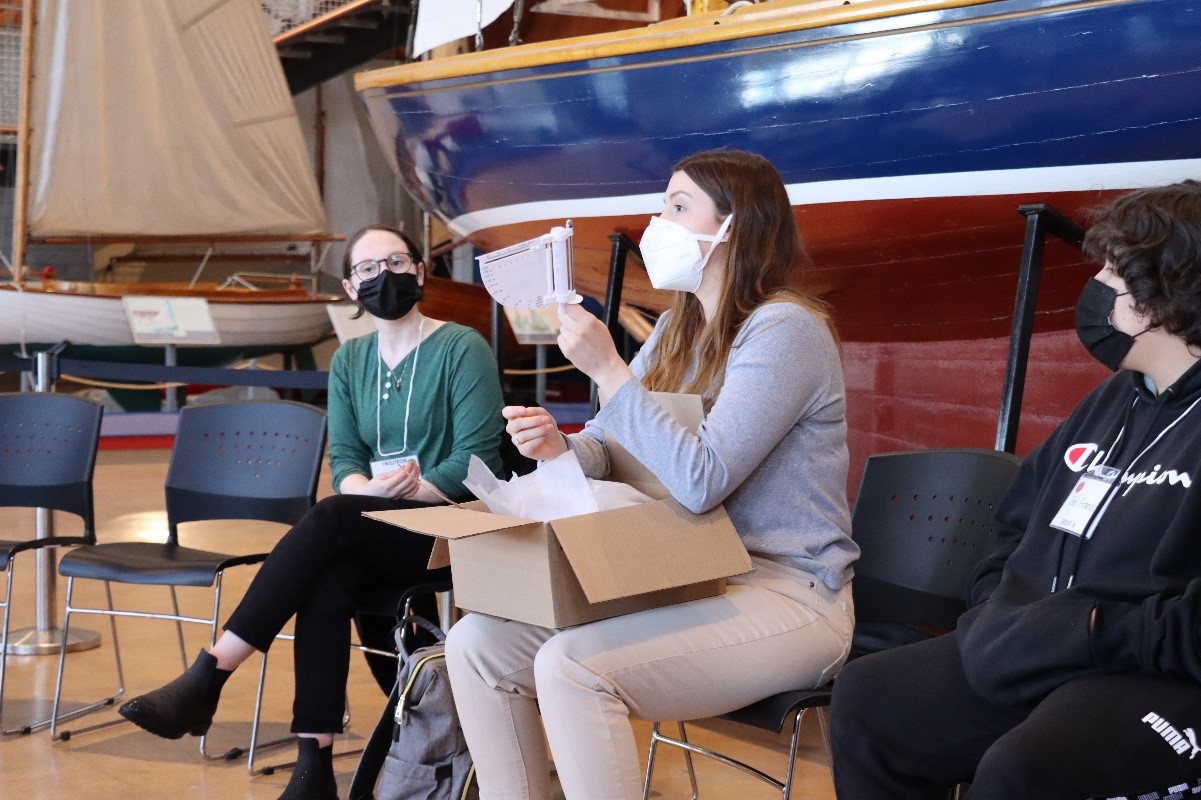By Lia Chin-Yet
The NSERC Promo-Science Two-Eyed Seeing Camp Program hosted a group of mainland Mi’kmaw youth late this winter for a special day of activities rooted in water (both frozen and not) in collaboration with the Maritime Museum of the Atlantic, and its usual partners including Mount Saint Vincent University, Sipekne’katik First Nation, Acadia First Nation, Pictou Landing First Nation, and Mi’kmaw Kina’matnewey.
Camp rooted in two-eyed seeing approach
The Two-Eyed Seeing Camp is based on the Mi’kmaw concept and guiding principles of Etuaptmunk (two-eyed seeing) which encourages integrating Indigenous and Western perspectives. The program draws from this concept to create programming that teaches youth about Mi’kmaw culture and Science Technology Engineering and Math (STEM). Originally exclusively a summer camp, this program has expanded in size and outreach, with input from its partners, and is now offering events and activities all year.
“This camp is an example experiential learning and of how science and traditional ways of knowing need not be considered exclusive or at odds. We offer all involved an opportunity to play, learn and explore, outside of the classroom, learning skills they can bring back to the classroom, their communities, and their life. Our recent efforts to integrate land-based and art-based learning is a natural evolution of this work and key to reconciliation and decolonizing education. We have had six rich years and are in preparation of applying for funding to cover three more years (fingers crossed).” – Dr. Shannan Grant, Co-founder and co-director of NSERC PromoScience Two-Eyed Seeing Camp Project
Building (and test driving!) toboggans
The event featured a toboggan building and testing activity, with Eamonn Doorly (Shipwright/Assistant Curator of Small Craft, Maritime Museum of the Atlantic), a tour of the Ta’n me’j Tel’keknuo’Ltiek: How Unique we Still Are Exhibit at the museum, and unboxing of The Land and Water Protection Kit, developed by the program team. It wrapped up with a water ceremony, led by Elder Dorene Bernard of Sipekne’katik First Nation.

The toboggan building activity gave youth an opportunity to learn a new skill, while co-creating something tangible (toboggan) and less tangible (relationships). The activity provided an opportunity for relationship building and co-learning among youth, chaperones, and facilitators – core components of Two-Eyed Seeing.
“The toboggans when we went outside, they were actually pretty cool…It was pretty fascinating, I learned how to tie a few knots, a bow knot, and a figurine, it was actually pretty fun.” – Joel Francis, youth participant from Sipekne’katik First Nation

The youth tested their toboggans on some snow on the Halifax waterfront – making sure that they were both functional and fun.
Learning about and from the land and water
The Land and Water Protection Kit explored by the youth included a variety of tools meant to encourage participants to spend more time on the land and take an active role in land and water monitoring and protection.
Tools in the box included a weather station used to monitor rain fall and windspeed, a water quality testing kit, a plant press, a solitary bee home, and a soil tester used to measure soil pH, fertility, moisture, and light. Each element was presented in a way that emphasized its relevance to both scientific and Mi’kmaw values. A handout on weather, for instance, explored examples of the Mi’kmaw moons as descriptors of weather and other environmental events throughout the year, which could be used alongside the weather station and other tools provided in the kit.
The significance of water and how it connects us was expanded on and demonstrated through a water ceremony led by Elder Dorene Bernard. During the ceremony, each participant held a cup of water and was asked to reflect on their relationship with water and how they can respect and honor it, drinking it later in the ceremony.

The success of this event was made possible by all involved, from the original work of Elders Albert and Murdena Marshall, to the involvement of the youth.
Special thanks to Ann Sylliboy (Post-Secondary Consultant with Mi’kmaw Kina’matnewey), liaison for MK, Velvet Paul (Director of Education) and Erika Hilchey (teacher and community-based chaperone), liaison to Sipekne’katik, Shane Theunissen (Associate Professor, Department of Child and Youth Study at MSVU, Salina Kemp (MMA Guest Curator), and Florence Blackett (Salina’s mother and an MSVU student), for expanding the existing partnerships and resources offered through the Two-Eyed Seeing Camp. The Maritime Museum of the Atlantic staff and the MSVU team facilitated the event seamlessly.
Keep your eyes peeled for spring and summer Two-Eyed Seeing Camp offerings, including boat building and an in-person day camp.
To keep up to date about opportunities or to get involved, follow us on social media @twoeyedseeingcamp or contact us at two-eyed-seeing-camp@msvu.ca.